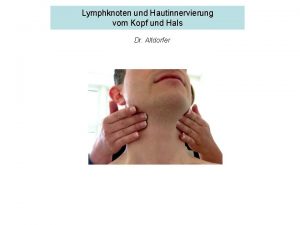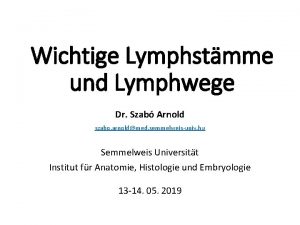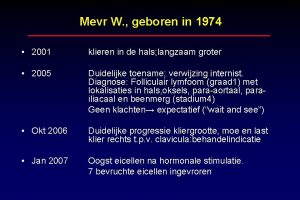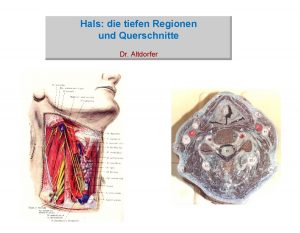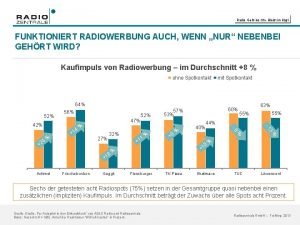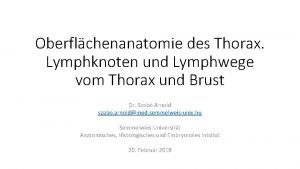Lymphknoten und Hautinnervierung vom Kopf und Hals Dr


















- Slides: 18

Lymphknoten und Hautinnervierung vom Kopf und Hals Dr. Altdorfer

Hautinnervierung Hals

Kopf Hautinnervierung: Gesicht: größtenteils N. V.




Gürtelrose In V/1 Gebiet

Lymphknoten und Lymphgefäße vom Kopf und Hals

Lymphknoten und Lymphgefäße vom Kopf und Hals 1. Kopf, oberfl.

2. Kopf, tief 1 2 3 1. Nodi lymphatici retropharyngei 2. Nodi lymphatici submandibulares 3. Nodi lymphatici cervicales profundi

1. Nodi lymphatici submentales 2. Nodi lymphatici submandibulares 3. Nodi lymphatici cervicales profundi Zunge

3. Hals Oberfl. : Nodi lymphatici cervicales superficiales neben V. jugularis ext. Tief: Nodi lymphatici cervicales profundi (neben Vagina carotica) - Nodi lymphatici tracheales Truncus jugularis Virchow-”Drüsen”: Lymphknoten: linke Seite, Nn. ly. supraclaviculares:

Nodi lymphh. parotidei spf. , Nodi lymphh. occiptales, retroauriculares submandibulares submentales cervicales profundi Truncus jugularis Nodi lymphh. supraclaviculares N. lymph. jugulodigastricus


Geschwollene Lymphknoten Lymphadenomegalia; Lymphadenitis • Entzünung • Lymphom / Leukämie; • Metastase– regionäre Lymphknoten (schmerzlos!) Lymphom: • Geschwollene Lymphknoten • Müdigkeit und Leistungsschwäche, Appetitlosigkeit und • Anfälligkeit für Infekte • Fieber (über 38 Grad Celsius) ohne andere erkennbare Ursache, • starker Nachtschweiß • Gewichtsverlust. Bei Verdacht auf ein malignes Lymphom entnehmen Ärzte einen Lymphknoten. „radikale Halsausräumung„ (= Neck dissection: Entfernen der Halsweichteile im Block (SCM, Lymphknoten, VJI, Fett…)

Wächterlymphknoten (Engl. : sentinel lymph node). -die erste regionale Lymphknoten / Filterstation der Lymphflüssigkeit, die Krebszellen auf ihrem Weg passieren müssen -während der Operation statt einer größeren Zahl von Lymphknoten oft der oder die Wächterlymphknoten entfernt. -vor dem Eingriff werden die Wächterlymphknoten mittels Szintigrafie aufgespürt und markiert.


 Lymphh
Lymphh Linker venenwinkel
Linker venenwinkel Normosthenic
Normosthenic Frenulum labii
Frenulum labii Który hals ma pierwszeństwo
Który hals ma pierwszeństwo Regionen hals
Regionen hals ørelæger randers
ørelæger randers Ontstoken neusvleugel
Ontstoken neusvleugel Descartes frans hals
Descartes frans hals Radio bleibt im kopf
Radio bleibt im kopf Radiowerbung bleibt im kopf
Radiowerbung bleibt im kopf Wenn du ein dach über dem kopf hast
Wenn du ein dach über dem kopf hast Geht ins ohr bleibt im kopf
Geht ins ohr bleibt im kopf Kopf katalin
Kopf katalin Radio geht ins ohr bleibt im kopf
Radio geht ins ohr bleibt im kopf Man kann den menschen nur vor den kopf schauen
Man kann den menschen nur vor den kopf schauen Geht ins ohr bleibt im kopf
Geht ins ohr bleibt im kopf Mehrkanaliges lernen
Mehrkanaliges lernen Zerbrich dir nicht über alles und jeden den kopf
Zerbrich dir nicht über alles und jeden den kopf
